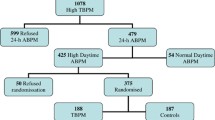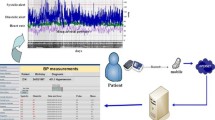Abstract
The rate of control of high blood pressure is disappointing, and noncompliance is one factor that contributes to this. The reasons for poor compliance are complex and include factors related to the patient, the healthcare provider, and the medical system. In general, the lack of regula communication between the patient and the physician, as occurs in the traditional model of clinic-based care, predicts a low rate of blood pressure control. In addition clinic-based blood pressure rates are notoriously unreliable. A solution to this dilemma is teletransmission of selfmeasured blood pressure readings, which offers the dual advantages of more reliable measurements, and the establishment of regular telephone communication between the patient and the healthcare provider. Preliminary evidence with this type of system suggests that blood pressure control can be improved substantially.
Similar content being viewed by others
References and Recommended Reading
Joint National Committee: The sixth report of the Joint National Committee on prevention, detection, evaluation, and treatment of high blood pressure. Arch Intern Med 1997, 157:2413–2446.
Shea S, Misra D, Ehrlich MH, et al.: Predisposing factors for severe, uncontrolled hypertension in an inner-city minority population N Engl J Med 1992, 327:776–781.
Shea S, Misra D, Ehrlich MH, et al.: Correlates of nonadherence to hypertension treatment in an inner-city minority population. Am J Public Health 1992, 82:1607–1612.
Berlowitz DR, Ash AS, Hickey EC, et al.: Inadequate management of blood pressure in a hypertensive population. N Engl J Med 1998, 339:1957–1963. This paper reviews the adequacy of blood pressure control in VA hypertension clinics, which have traditionally had some of the best results, but no longer. Despite free medications and frequent visits, control rates are disappointing, in part because of inaction by the physicians.
Stason WB, Shepard DS, Perry HMJ, et al.: Effectiveness and costs of veterans affairs hypertension clinics. Med Care 1994, 32:1197–1215.
Skaer TL, Sclar DA, Markowski DJ, Won JK: Effect of valueadded utilities on prescription refill compliance and Medicaid health care expenditures: a study of patients with non-insulin-dependent diabetes mellitus. J Clin Pharm Ther 1993, 18:295–299.
Shea S, Du MW, Bahamonde L: A meta-analysis of 16 randomized controlled trials to evaluate computer-based clinical reminder systems for preventive care in the ambulatory setting J Am Med Inform Assoc 1996, 3:399–409.
Campbell NRC, Myers MG, McKay DM: Is usual measurement of blood pressure meaningful? Blood Press Monit 1999, 4:71–76. A comparison of physicians’ usual clinic blood pressure measurements with standardized clinic measurements an ambulatory readings, all of which were related to echocardiographically determined left ventricular mass, showed that the usual measurements were at variance with the others and provides further evidence that doctors do not take good blood pressure readings.
Pickering TG, James GD, Boddie C, et al.: How common is white coat hypertension? JAMA 1988, 259:225–228.
Coats AJS, Radaelli A, Clark SJ, et al.: The influence of ambulatory blood pressure monitoring on the design and interpretation of trials in hypertension. J Hypertens 1992, 10:385–391.
Myers MG: Ambulatory blood pressure monitoring: guidelines for use in clinical practice. Can J Cardiol 1996, 12:1271–1275.
Mancia G, Zanchetti A, Agabiti-Rosei E, et al.: Ambulatory blood pressure is superior to clinic blood pressure in predicting treatment-induced regression of left ventricular hypertrophy: Study on Ambulatory Monitoring of Blood Pressure and Lisinopril Evaluation (SAMPLE). Circulation 1997, 95:1464–1470. An important paper that evaluates the consequences that treatment of hypertension does not produce identical reductions of blood pressure in clinic, home, and ambulatory readings. All three were correlated to regression of left ventricular mass. The best predictor of regression was the ambulatory readings, followed by the home readings, and the clinic readings.
Porchet M, Bussien JP, Waeber B, et al.: Unpredictability of blood pressures recorded outside the clinic in the treated hypertensive patient. J Cardiovasc Pharmacol 1986, 8:332–335.
Staessen JA, Byttebier G, Buntinx F, et al.: Antihypertensive treatment based on conventional or ambulatory blood pressure measurement: a randomized controlled trial. Ambulatory Blood Pressure Monitoring and Treatment of Hypertension Investigators. JAMA 1997, 278:1065–1072. A drug treatment trial that compared titrating the medication either according to clinic blood pressure or to ambulatory blood pressure. Patients treated according to the ambulatory pressure ended up on less medication without any evidence of adverse consequences.
Stahl SM, Kelley CR, Neill PJ, et al.: Effects of home blood pressure measurement on long-term BP control. Am J Public Health 1984, 74:704–709.
Vrijens B, Goetghebeur E: Comparing compliance patterns between randomized treatments. Control Clin Trials 1997, 18:187–203.
Edmonds D, Foerster E, Groth H, et al.: Does self-measurement of blood pressure improve patient compliance in hypertension? J Hypertens 1985, 3(suppl):S31-S34.
Ibrahim MM, Tarazi RC, Dustan HP, Gifford RWJ: Electrocardiogram in evaluation of resistance to antihypertensive therapy. Arch Intern Med 1977, 137:1125–1129.
Kleinert HD, Harshfield GA, Pickering TG, et al.: What is the value of home blood pressure measurement in patients with mild hypertension? Hypertension 1984, 6:574–578.
Verdecchia P, Bentivoglia M, Providenza M, et al.: Reliability of home self-recorded arterial pressure in essential hypertension in relation to the stage of the disease. In Blood Pressure Recording in the Clinical Management of Hypertension. Edited by Germano G. Rome: Ediziono Pozzi; 1985:40–42.
Abe H, Yokouchi M, Saitoh F, et al.: Hypertensive complications and home blood pressure: comparison with blood pressure measured in the doctor’s office. J Clin Hypertens 1987, 3:661–669.
Tsuji I, Imai Y, Nagai K, et al.: Proposal of reference values for home blood pressure measurement: prognostic criteria based on a prospective observation of the general population in Ohasama, Japan. Am J Hypertens 1997, 10:409–418.
Imai Y, Ohkubo T, Tsuji I, et al.: Prognostic value of ambulatory and home blood pressure measurements in comparison to screening blood pressure measurements: a pilot study in Ohasama. Blood Press Monit 1996, 1 (suppl 2):51–58.
Ohkubo T, Imai Y, Tsuji I, et al.: Reference values for 24-hour ambulatory blood pressure monitoring based on a prognostic criterion: the Ohasama Study. Hypertension 1998, 32:255–259. So far, the only prospective study using home blood pressures t predict morbidity.
Yarows S, Brook R: Comparability of 12 electronic home blood pressure devices using normotensive subjects [abstract]. J Hypertens 1999, 17 (suppl. 3):298.
Mengden T, Hernandez Medina RM, et al.: Reliability of reporting self-measured blood pressure values by hypertensive patients. Am J Hypertens 1998, 11:1413–1417. Patients were given a monitor and asked to record their readings in a log. They were not told that the readings were also recorded in the device’s memory, and there were discrepancies between the two sets of readings.
Myers MG: Self-measurement of blood pressure at home: the potential for reporting bias. Blood Press Monit 1998, 3(suppl 1):19–22 Essentially the same design and similar findings as the Mengden study [26•].
Krakoff LR: Myth and fact: reliability of self-reported blood pressures [editorial]. Am J Hypertens 1998, 11:1418–1419.
Stergiou GS, Thomopoulou GC, Skeva II, Mountokalakis TD: Home blood pressure normalcy: the DIDIMA Study [abstract]. J Hypertens 1999, 17(suppl 3):25.
Pickering T: Recommendations for the use of home (self) and ambulatory blood pressure monitoring: American Society of Hypertension Ad Hoc Panel. Am J Hypertens 1996, 9:1–11.
Mazze RS, Shamoon H, Pasmantier R, et al.: Reliability of blood glucose monitoring by patients with diabetes mellitus. Am J Med 1984, 77:211–217.
Gerin W, Holland J, Glenn J, et al.: Telephone-linked home blood pressure monitoring in the management of hypertension [abstract]. Circulation 1998, 98(supp l1):324.
Gerin W, Pickering TG, Holland JK, Alter R: Telephone-linked home blood pressure monitoring may improve management [abstract]. Am J Hypertens 1999, 12:163. Describes preliminary results showing improved blood pressure control using a telephone linked home monitoring system.
Mengden T, Beltran B, Weisser B, et al.: Long term control of blood pressure guided by daily self-measurement of blood pressure is superior to usual office-based care [abstract]. J Hypertens 1999, 17(suppl 3):30. Home monitoring led to improved blood pressure control when compared with usual care.
Bondmass MD, Bolger NE, Castro GM, et al.: Rapid control of hypertension in African Americans achieved utilizing home monitoring [abstract]. Circulation 1998, 98(suppl 1):517.
Denolle T, Weber JL, Calvez C, et al.: Blood pressure measured telemetrically in hypertension pregnant women [abstract]. J Hypertens 1999, 17(suppl 3):228.
Dalton KJ, Manning K, Roberts PJ, et al.: Computerized home telemetry of maternal blood pressure in hypertensive pregnancy Int J Biomed Comput 1987, 21:175–187.
Author information
Authors and Affiliations
Rights and permissions
About this article
Cite this article
Pickering, T.G., Gerin, W. & Holland, J.K. Home blood pressure teletransmission for better diagnosis and treatment. Curr Hypertens Rep 1, 489–494 (1999). https://doi.org/10.1007/s11906-996-0020-0
Issue Date:
DOI: https://doi.org/10.1007/s11906-996-0020-0




